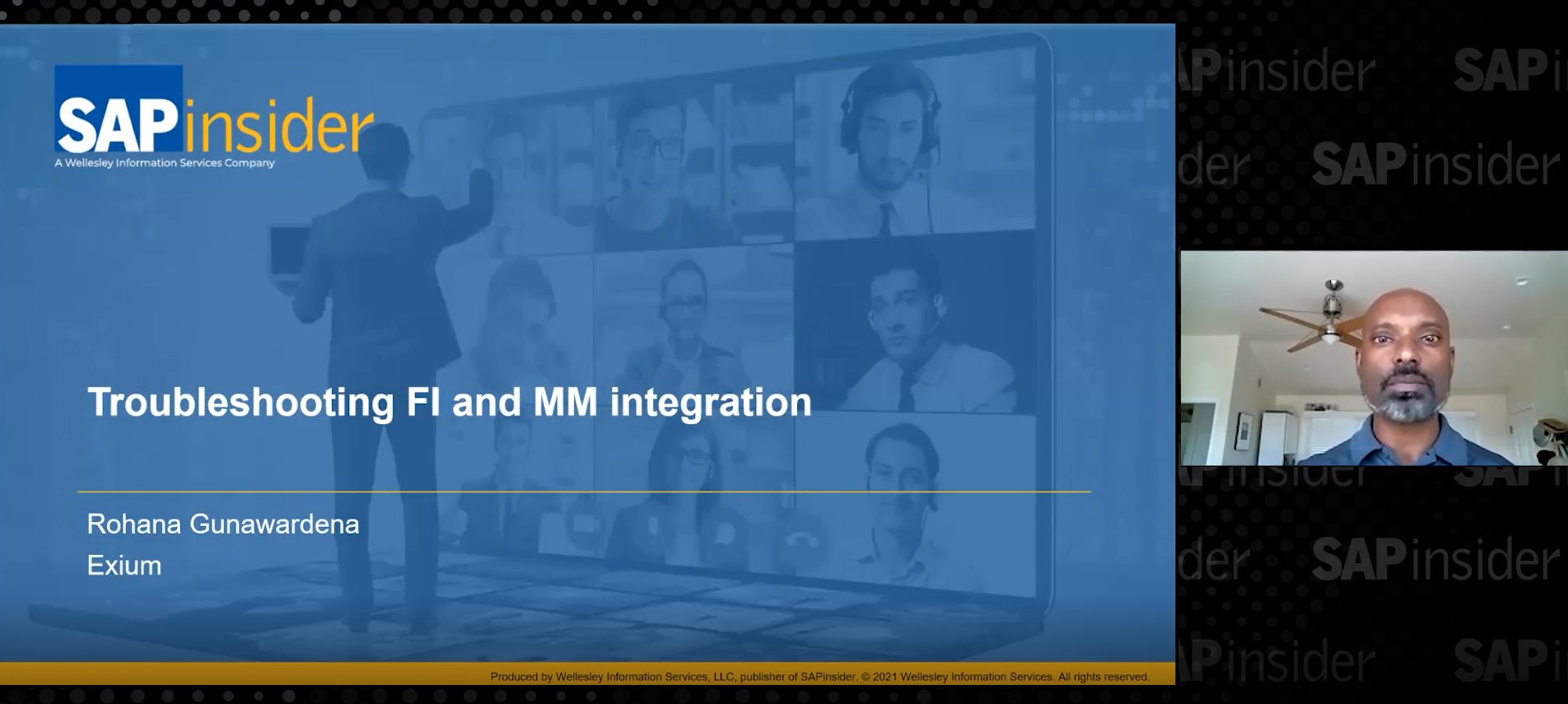Product Profitability and New Materials Ledger on SAP S/4HANA Finance
Q&A with Financials 2017 speaker Kumar T. Piraviperumal
Kendall Hatch: Hello, and thanks for joining us today for our live Q&A on product profitability and new materials ledger on SAP S/4HANA Finance. We’re joined by Deloitte’s Kumar T. Piraviperumal who will be with us answering questions for the next hour. Kumar is speaking at the upcoming SAPinsider Financials conference, taking place in Amsterdam 14-16 June. To learn more about the event, click here[AA1] .
Kumar, thanks for joining us!
Kumar T Piraviperumal: Thanks, Kendall, Happy to be here and happy to be at the conference the week of June 14th and meet all the participants.
Comment From Agen: We are currently on SAP ERP release 617 and using materials ledger in a limited number of legal entities. We don’t use the multiple currency functionality — we only use the monthly stock revaluation functionality. We are planning on implementing SAP S/4HANA later this year. Is there any workload to be planned for the materials ledger module when we will do the migration to SAP S/4HANA? We didn’t activate the new GL on our system.
Kumar T Piraviperumal: Yes, you will need to factor in the effort to migrate to new materials ledger even in your scenario. The following SAP Notes will help evaluate your effort: 2416935, 2396864, 2267834, 2337383, 2337368.
Comment From Anand: What are the various ways for apportioning variances to co-products scenarios? Currently, we are using ratio of actual receipt quantities to apportion the variances to co-products. This does not seem to work when we have low receipt and high variance for a particular co-product.
Kumar T Piraviperumal: Since co-products and by-products are sometimes limited from receipts, you may actually get a better allocation using a volumetric approach using your ratios of product to co-product and by-product than actual receipts. You need to look at your industry and product structure to see if there are any other standard ways better than actual production ratios.
Comment From Guest: What are some best practices for product profitability data modelling and analytics?
Kumar T Piraviperumal: Best practices for product profitability is dependent on the industry, market, and type of product. In many cases, both top-down and bottoms-up product profitability will be applicable. The general best practice is to balance the effort for data collection and analysis, focusing on controllable cost elements which will result in material impact in product decision making.
Comment From Paulo: For actual costing with material ledger to transfer actual cost components, do we need to activate costing-based CO-PA on top of the account-based CO-PA? Does that normally require combining the data from both types of CO-PA?
Kumar T Piraviperumal: Refer to SAP Note 2337383. No, you can do this with account-based CO-PA.
Comment From Paulo: Can you please discuss the impact of IFRS 15 (RAR) on CO-PA setup?
Kumar T Piraviperumal: This is revenue recognition. There are many considerations, like account-based versus cost-based to performance obligations and cost of goods sale calculation. Happy to discuss this during the conference offline.
Comment From Anumolu Sridhar: I am unable to see table MATDOCA in SAP S/4HANA test system.
Kumar T Piraviperumal: What version of SAP S/4HANA are you on? You need to be in SAP S/4HANA 1511 or 1610 for viewing MATDOCA.
Comment From Michael: What are the new main functions within SAP S/4HANA 1610 in regards of material ledger and product profitability analysis?
Kumar T Piraviperumal: There is quite a bit of simplification for materials ledger with actual costing. Some of the key functionality changes are around actual costing and transfer price changes (see SAP Notes 2354768 and 2270414) from a business point of view. This provides various hard-to-get analytics.
The technical changes can be found under the simplification list from pages 121-253. In my session during the conference, I plan to provide a simple Microsoft Excel file with all the changes and impacts as a part of the session hand out.
Comment From MEDuus: I am on a 1610 test system that displays “Table MATDOCA is not active in the dictionary.” Shouldn’t the new ledger be mandatory to activate during migration?
Kumar T Piraviperumal: You need to activate the business function as a part of install and processing. Refer to SAP Note 2337383 for help and prerequisite actions.
Comment From Jonathan: Material ledger is mandatory for material valuation in SAP S/4HANA, correct? What are the potential benefits of a bigger material ledger footprint than strictly what’s mandatory?
Kumar T Piraviperumal: Correct, material ledger is mandatory. The SAP Note 2267834 will provide additional information. As to benefits of expanding your foot print, it depends on your key tracking needs. Many of my clients are looking to use the opportunity to track actual costing and variances at a more granular level. Some are interested in valuations in currency and transfer price analytics. The art of possibility is endless. We will be reviewing some large manufacturing scenario in my session at the conference and walking through some sample achieved and planned benefits.
Comment From Nate: What are the key configuration and master data set-up techniques needed to track cost and sales?
Kumar T Piraviperumal: Materials master set up, account-based or cost-based CO-PA set up, and materials movement set up are some of the major categories for configuration and master data set up which are needed to track accurate actuals cost. If you are attending the conference, we can catch up and discuss your industry and your scenarios offline.
Kumar T Piraviperumal: Thanks for joining us in this session. I hope to meet many of you in the upcoming conference in June. I will be starting a live feed of Art of Possibility for SAP S/4HANA 1610, Materials Ledger for Profitability Analytics on my Twitter account closer to my Session. Please feel free to connect and follow me at @kpiravi_dt (https://twitter.com/intent/user?screen_name=@kpiravi_dt).
Kendall Hatch: Hello, and thanks for joining us today for our live Q&A on product profitability and new materials ledger on SAP S/4HANA Finance. We’re joined by Deloitte’s Kumar T. Piraviperumal who will be with us answering questions for the next hour. Kumar is speaking at the upcoming SAPinsider Financials conference, taking place in Amsterdam 14-16 June. To learn more about the event, click here[AA1] .
Kumar, thanks for joining us!
Kumar T Piraviperumal: Thanks, Kendall, Happy to be here and happy to be at the conference the week of June 14th and meet all the participants.
Comment From Agen: We are currently on SAP ERP release 617 and using materials ledger in a limited number of legal entities. We don’t use the multiple currency functionality — we only use the monthly stock revaluation functionality. We are planning on implementing SAP S/4HANA later this year. Is there any workload to be planned for the materials ledger module when we will do the migration to SAP S/4HANA? We didn’t activate the new GL on our system.
Kumar T Piraviperumal: Yes, you will need to factor in the effort to migrate to new materials ledger even in your scenario. The following SAP Notes will help evaluate your effort: 2416935, 2396864, 2267834, 2337383, 2337368.
Comment From Anand: What are the various ways for apportioning variances to co-products scenarios? Currently, we are using ratio of actual receipt quantities to apportion the variances to co-products. This does not seem to work when we have low receipt and high variance for a particular co-product.
Kumar T Piraviperumal: Since co-products and by-products are sometimes limited from receipts, you may actually get a better allocation using a volumetric approach using your ratios of product to co-product and by-product than actual receipts. You need to look at your industry and product structure to see if there are any other standard ways better than actual production ratios.
Comment From Guest: What are some best practices for product profitability data modelling and analytics?
Kumar T Piraviperumal: Best practices for product profitability is dependent on the industry, market, and type of product. In many cases, both top-down and bottoms-up product profitability will be applicable. The general best practice is to balance the effort for data collection and analysis, focusing on controllable cost elements which will result in material impact in product decision making.
Comment From Paulo: For actual costing with material ledger to transfer actual cost components, do we need to activate costing-based CO-PA on top of the account-based CO-PA? Does that normally require combining the data from both types of CO-PA?
Kumar T Piraviperumal: Refer to SAP Note 2337383. No, you can do this with account-based CO-PA.
Comment From Paulo: Can you please discuss the impact of IFRS 15 (RAR) on CO-PA setup?
Kumar T Piraviperumal: This is revenue recognition. There are many considerations, like account-based versus cost-based to performance obligations and cost of goods sale calculation. Happy to discuss this during the conference offline.
Comment From Anumolu Sridhar: I am unable to see table MATDOCA in SAP S/4HANA test system.
Kumar T Piraviperumal: What version of SAP S/4HANA are you on? You need to be in SAP S/4HANA 1511 or 1610 for viewing MATDOCA.
Comment From Michael: What are the new main functions within SAP S/4HANA 1610 in regards of material ledger and product profitability analysis?
Kumar T Piraviperumal: There is quite a bit of simplification for materials ledger with actual costing. Some of the key functionality changes are around actual costing and transfer price changes (see SAP Notes 2354768 and 2270414) from a business point of view. This provides various hard-to-get analytics.
The technical changes can be found under the simplification list from pages 121-253. In my session during the conference, I plan to provide a simple Microsoft Excel file with all the changes and impacts as a part of the session hand out.
Comment From MEDuus: I am on a 1610 test system that displays “Table MATDOCA is not active in the dictionary.” Shouldn’t the new ledger be mandatory to activate during migration?
Kumar T Piraviperumal: You need to activate the business function as a part of install and processing. Refer to SAP Note 2337383 for help and prerequisite actions.
Comment From Jonathan: Material ledger is mandatory for material valuation in SAP S/4HANA, correct? What are the potential benefits of a bigger material ledger footprint than strictly what’s mandatory?
Kumar T Piraviperumal: Correct, material ledger is mandatory. The SAP Note 2267834 will provide additional information. As to benefits of expanding your foot print, it depends on your key tracking needs. Many of my clients are looking to use the opportunity to track actual costing and variances at a more granular level. Some are interested in valuations in currency and transfer price analytics. The art of possibility is endless. We will be reviewing some large manufacturing scenario in my session at the conference and walking through some sample achieved and planned benefits.
Comment From Nate: What are the key configuration and master data set-up techniques needed to track cost and sales?
Kumar T Piraviperumal: Materials master set up, account-based or cost-based CO-PA set up, and materials movement set up are some of the major categories for configuration and master data set up which are needed to track accurate actuals cost. If you are attending the conference, we can catch up and discuss your industry and your scenarios offline.
Kumar T Piraviperumal: Thanks for joining us in this session. I hope to meet many of you in the upcoming conference in June. I will be starting a live feed of Art of Possibility for SAP S/4HANA 1610, Materials Ledger for Profitability Analytics on my Twitter account closer to my Session. Please feel free to connect and follow me at @kpiravi_dt (https://twitter.com/intent/user?screen_name=@kpiravi_dt).







